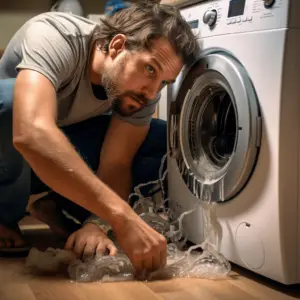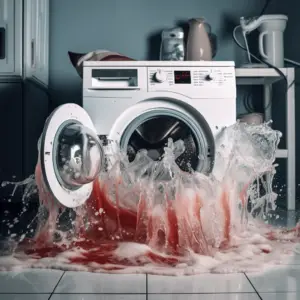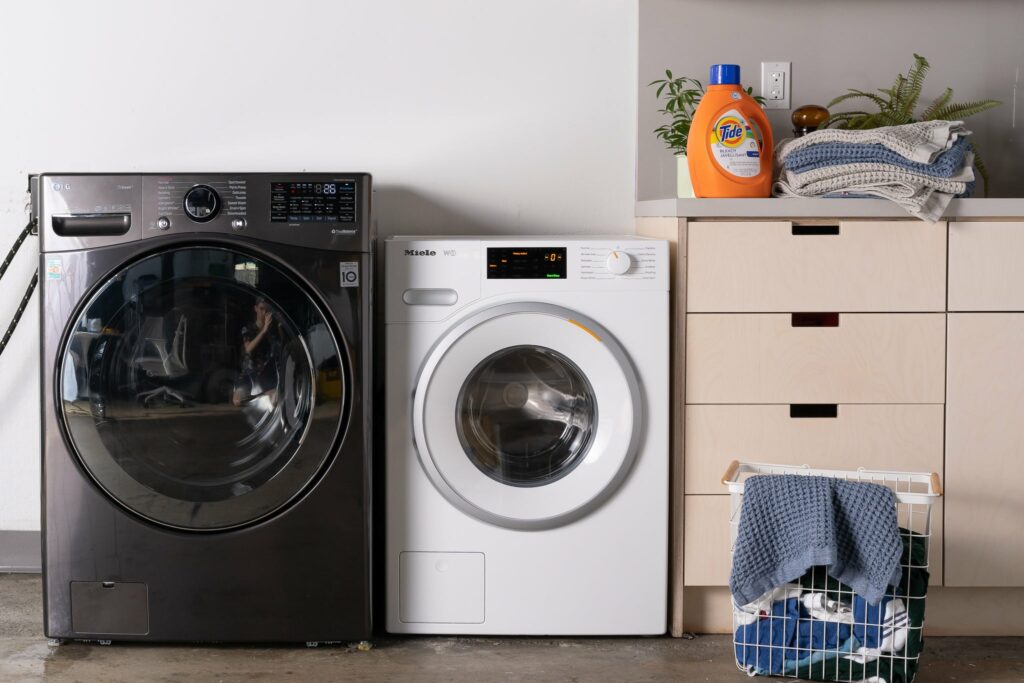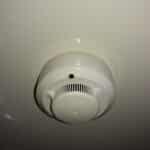Washing machine leaks, may often find water on the floor when you use your washing machine. It can be either behind, in front, or underneath. It is a clear sign that your washer leaks. Therefore it is significant to check out the source of the leak.
There are multiple reasons why the washing machine leaks may be leaking from the bottom. This issue can damage your home if not fixed immediately. Most leakages would be due to a loose faulty pump, damaged pressure switch, improper installation, too much detergent, etc., as we shall tackle that in our subsequential topics.
This guideline focuses on the causes and how to repair them. Let’s get started.
Table of Contents
What Do You Do When Washing Machine Is Leaking Water From the Bottom

Most new machines are so complex to fix; hence overwhelming to start figuring out where the source of the leak would be. Start by removing the access panel and running the washing machine to establish the possible leak source.
The type of your washer determines (top-loader or front-loader washer) which internal part might be responsible for the leakage. For instance, certain top-loaders may have an access panel at the washer rear though others need you to remove the top panel, washer cabinet, or control panel.
Front-loaders usually have an access panel at the lower side of the washer underneath the door. It is recommendable to check your manual to be sure.
Possible Causes of the Washing Machine Leaking Water From the Bottom
External Drain Hose
Check the drain hose for any punctures or disconnection due to the impact caused by pushing the washer near the wall and the washer’s vibrations, causing it to split.
Damaged Door Seal
It can get punched or torn or even lose its elasticity, thus allowing water to seepage during washing. Check the seal’s condition by feeling its whole circumference with your hand. A replacement should be done if there are signs of wear and tear.
Improper Installation
There are a few things you should watch out for when installing:
Ensure the water hose is not wet by wiping the connections with a piece of towel.
Don’t insert the drain hose profoundly into the plumbing standpipe, as it could lead to an overflow and result in leakage.
The standpipe’s open end should be at least 65 cm above the ground, with the hose injected at a depth of no more than 15cm.
Lastly, ensure the water isn’t overflowing from the standpipe
Excess Use of Detergent
The drum’s movements during washing (agitation) create foam. If you have put much detergent, it will overflow, seeping through into the floor. In addition, if you reside in a soft-water area, ensure you significantly minimize the amount you use or use a washing-up liquid instead.
Tip: Most eco-friendly detergents/ powders. Also, note that when you run the “wool program” on some appliances, they have high frequency resulting in larger amounts of foam to be formulated and increasing the chances of leaks.
Drain Pump Clog
This part empties the water from your washer. Therefore, it is easy to notice any water that escapes through the spindle or the filter. Angle the machine up and check beneath. The filter clogs result in leakages during laundry cycles.
Do regular cleaning of the filters (located on the right bottom and easily reachable)
Blocked Pressure Chamber
The pressure chamber exerts the air to the pressure switch to show the tub water levels. Over time, it accumulates with dirt and muck, thus preventing the device from noticing the water levels leading to continuous water fill that leads to a water overflow.
Damaged pressure switch
This part of the washing machine leaks enables your unit to sense the water level in the tub. A defective pressure switch may lead to your appliance holding more water than required, likely overflowing.
To inspect the pressure switch, you need to disconnect the control panel from the unit and check its condition. Replace if need be.
Examine Water Inlet Valve
Tighten the inlet pipe so that the seals stop water from leaking. When it is not securely tightened, the outcome may be leaking out of the pipe injection. You can fasten it with pliers or hands.
Clean the valve screens from dirt and other debris as they hinder the valve’s ability to regulate water entry. The water from external sources leads to leaks from the machine’s bottom.
Any damage on the valve or odd readings need to be replaced.
Worn Bearings
The Bearings facilitate the drum spinning on its spindle. Check out for rust or blackish marks beneath the machine, accompanied by a nasty rolling sound when spinning.
You can troubleshoot the machine’s bearing conditions by circling the drum rapidly by hand while it is off.
Defective Cuff
Another problem causing the bottom leaks from your machines would be a broken coupler. A rubber or plastic seal breaks if there is a failure to save the appliance from being damaged.
It causes leaks and soaking of clothes after a cycle; therefore, you will have to replace them.
Detergent Drawer Leak
Laundry cleaners also contribute to leakages. If your drawer leaks, it causes rust to pile around the area. Ensure you adhere to the manual’s instructions for use.
What Parts To Look Out For When a Leakage Occur

Knowing the internal parts that link to leakages in a washing machine will save you time. Here is a list of the most common parts that might require replacement are:
- Hoses
- Pump
- Door seal
- Pressure switch
- Gaskets
- Water inlet valve
Is Repairing a Leaking Machine Worth it?
Most factors that cause leakages are repairable for a significantly lower cost than a brand new machine. You can fix some of the issues by yourself based on how easily the parts are accessible.
Bottom leakages in washing machines can be out for multiple reasons. Therefore the best option to repair your appliance is to establish the leakage source. Secondly, consider which parts may be causing the washer. Read the manual as each model and- top-loading and front-loading washing machines require various repair methods.


